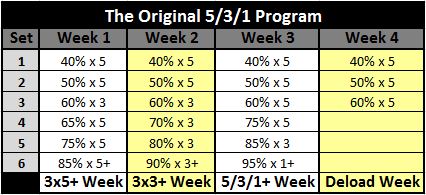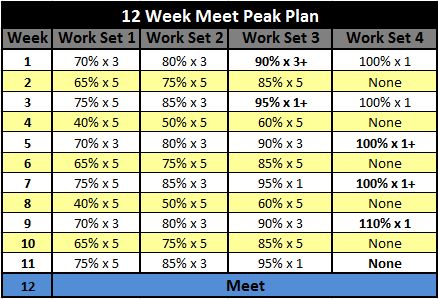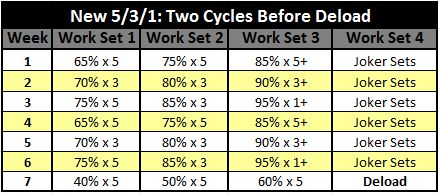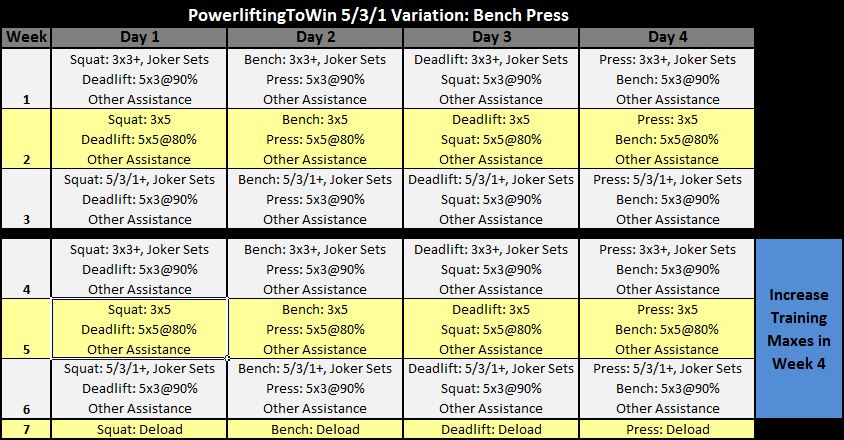In today’s program review, we’re going to be tackling Jim Wendler’s iconic 5/3/1 system. Now, before I begin, it is extremely important to note that 5/3/1 is not a generic, cookie cutter “program” that you can easily analyze. Through his different book publications, including the original 5/3/1
, 5/3/1 for Powerlifting
, and Beyond 5/3/1
, Jim Wendler has produced well over 500 pages of content regarding the 5/3/1 system.
In these books, Wendler offers, quite literally, several dozen different versions of 5/3/1 that address a variety of goals from improving conditioning, getting faster and jumping higher, improving general strength, and, yes, setting PRs on the big three for powerlifting purposes.
Please understand that it would be virtually impossible to offer a comprehensive review of every single variation of 5/3/1 in a single review. Unless you guys want to read a 100,000 word article, or watch a four hour video, I’m going to have to stick to the basic, popular versions of 5/3/1 that are floating around the internet.
Whenever possible, as I am addressing the original 5/3/1 program, I am going to make notations about revisions Jim has made in the more current book Beyond 5/3/1. Keep in mind that the original 5/3/1 was published five years ago in 2009. Wendler has made substantial changes and, in my opinion, improvements to that original template. Nonetheless, most people still use the original variation and our review is going to center upon that particular version of 5/3/1.
That said, I’d strongly recommend that you consider picking up a copy of Beyond 5/3/1 if you’re interested in doing ANY variation of the program. The book contains Wendler’s latest and greatest ideas with regards to 5/3/1. If you’re not familiar with “First Set Last” or “Joker Sets”, your knowledge base on 5/3/1 is out of date. Without understanding of these concepts, which are discussed in Beyond 5/3/1, you’re not actually doing Wendler’s current program.
If you’d rather watch than read:
5/3/1 History and Context
As always, we’re going to start with a bit of context about the origins of the 5/3/1 program. Ironically, given its popularity in the powerlifting community, 5/3/1 was the program Jim Wendler invented when he decided to move away from the sport. That’s right; Jim Wendler invented 5/3/1 when he quit powerlifting.
In his own words, more or less, Wendler was tired of being a “fatass” who wasn’t good for anything other than waddling up to a monolift and squatting. He claims he was so out of shape that he actually lost his breath just walking around the block. As such, he wanted to come up with a program that took a more holistic approach to strength; he wanted to incorporate conditioning and mobility into his overall plan of attack.
Wendler decided to strip away the complexities of the Westside style of training that he had been using and he reverted to a simple percentage based program. In all likelihood, 5/3/1 was probably influenced by the Bigger, Stronger, Faster lifting program that Wendler was almost certainly exposed to as a youth football player. This program, designed with the competitive athlete in mind, served as a fantastic frame work for someone looking to improve their overall condition rather than focus explicitly on powerlifting performance.
To make my point explicitly clear, Wendler’s original program was specifically designed as an alternative to powerlifting training. 5/3/1 was never intended to be a powerlifting-centric, powerlifting-specific program. You must keep that in mind.
5/3/1: The Actual Program
Let’s take a look at the bones of 5/3/1.
As you can see, 5/3/1 is a program with a monthly mesocycle. There are four distinct microcylces: 3×5+ week, 3×3+ week, 5/3/1+ week, and a deload. The key notation to make is that the “+” sets mean you do as many reps as possible (AMRAP). You’re not supposed to go to failure on the AMRAP sets, but you are supposed to come within a rep or so of failure.
The entire program centers around the concept of the “training max”. Essentially, using a rep max calculator, you estimate your true one rep max. You then multiply this number by 90% in order to find your training max. Using this training max, all of your work set weights are calculated based on the percentages shown above.
If you don’t want to do all that math, you can have your 5/3/1 workouts calculated here.
5/3/1 Progression
At the end of each month, you increase your training max weight on the lower-body movements, the squat and the deadlift, by 10lbs; you increase your training max on the upper-body movements, the bench and the press, by 5lbs. From there, you repeat the exact same workouts that you did the month before with slightly heavier weights.
In addition to the monthly incremental increases, the program also allows for “rep maxes”. So, even if the weight increases are only monthly, you can still theoretically make progress from week to week by adding reps.
Planning
Although the original 5/3/1 program was never intended for powerlifters, Wendler has since addressed this issue in both 5/3/1 for Powerlifting and Beyond 5/3/1
. In Beyond 5/3/1, Wendler offers an 11-12 week meet peaking cycle.
Here is what it looks like:
As you can see, the peaking plan is relatively simple and effective. In the first month, the lifter increases specificity by adding some heavy singles using his training max weight after he does his AMRAP sets. In month two, the lifter starts using his training max weight as the AMRAP set. In month three, you cut out all AMRAP sets and add an additional super heavy single.
During the last month, by eliminating the AMRAP sets, you allow for an extended “recovery” period where fatigue dissipates. By still including the ultra heavy single, you prevent detraining and encourage further acclimation to heavy weights. In Week 11, where even all the assistance is cut out, you ensure full recovery going into Meet Week.
Overall, this is a solid peaking option for the lifter who is using 5/3/1.
Periodization
In Beyond 5/3/1, Wendler offers 26-28 week training plans that include periodized focuses on hypertrophy, conditioning, and strength. However, the original 5/3/1 template is not what you would consider periodized.
Programming
Unlike the other programs we’ve looked at thus far, the 5/3/1 program does feature a monthly mesocycle with once monthly weight increases. In reality, this makes the program most suited for “advanced” intermediate athletes. Early intermediates can make progress much more quickly than once per month. And even though 5/3/1 allows for rep maxes, it is much harder to add one rep per week than it is to add ~2-5lbs/1-2kg per week.
One of the biggest criticisms of 5/3/1 is the lack of overall frequency for the powerlifts. You perform each lift only once per week. For the vast majority of trainees, this simply isn’t optimal in terms of technical development. You’re going to need more weekly exposures to the lift in order to master your technique. Now, there are a variety of 5/3/1 templates that function to increase frequency. For powerlifting purposes, where technique is paramount, I think it is necessary to choose one of them. You can find many such examples in Beyond 5/3/1.
In my opinion, getting your squat and bench frequency to at least twice per week is going to be the minimum acceptable level. I personally prefer to see benching happening at least three times a week and even twice weekly pulling, but many people do just fine with benching twice a week and pulling only once. If you’re going to do 5/3/1 for powerlifting, make sure to use a variation where the frequency is increased.
Specificity
In terms of specificity, I think you know what I’m going to say. The program isn’t specific enough because it wasn’t designed explicitly for powerlifting. The entire idea behind 5/3/1 was to move away from powerlifting centric training and focus on a more holistic approach to strength. The entire program is designed to allow for more conditioning, more overall recovery, and a better general sense of well-being. These goals and aims are well and good, but many run contradictory to maximizing powerlifting performance.
Like many other programs we’ve seen, the emphasis on the 1:1 bench to press ratio is just unnecessary and sub-optimal for powerlifters. The majority of the upperbody training needs to be focused on the bench press.
The biggest failing of 5/3/1, in terms of specificity, is in the percentages used by the program. Let’s do some math. If we’re taking 90% of our true max as the base for our program, and then take 85% of that number in Week One, 90% of that number in Week Two, and 95% of that number in Week Three, our “actual” percentages are: 76.5%, 81%, and 85.5%. In other words, for the vast majority of months that you spend doing 5/3/1, you spend exactly one week above 85% of your true max.
For a powerlifter, this is an absolutely sub-optimal approach. Now I’m not saying that you won’t get any stronger from working at lighter percentages, but I am saying that spending so little time in the powerlifter’s money range, 80-90%, is a recipe for sub-optimal progress. The lighter percentages, while great for long-term, sustained progress, completely bias the program towards hypertrophy and away from strength. It isn’t that uncommon for people to get 5-8 reps on their 5/3/1+ week which is supposed to be the “heavy” week.
Look, if you want to lift heavy stuff, you have to lift heavy stuff. It is really that simple. In fact, if we’re being honest, even Wendler has recognized that this was a weakness of his program for powerlifters. He addresses this weakness in 5/3/1 for Powerlifting through the following adjustment to the program:
As you can see, Weeks One and Two are switched. The AMRAP set is removed from the 3×5 week and heavy singles at your training max are added to Weeks 1 and 3. Now, this is a good start towards improving specificity. But let’s be honest here, do you really think doing a couple of singles, which still represents a relatively small amount of volume, is enough to override the fact that the vast majority of work that you do on the program is below 85%? Well, it isn’t.
In Beyond 5/3/1, Wendler further addresses this deficiency with the addition of Joker sets. With Joker sets, you can keep working up to heavier and heavier work sets after your AMRAP. For example, after you go for your rep max on 3×3+ Week, you can keep doing heavier triples. You are supposed to “listen to your body” and stop before you go to a weight where you would fail. In other words, you’re supposed to incorporate autoregulation, but you’re given no real guidelines as to how to actually do that. Beyond that oversight, the Joker sets do at least allow for you to get some work done in that 85%+ range. This is a key addition for all powerlifters. You can read more about Joker sets in Beyond 5/3/1
.
Overload
5/3/1 employs a combination of basic progressive overload and attempting to add more reps. On the one hand, you increase your training max by a fixed linear increment every single month. This results in heavier poundages being used over time – also known as progressive overload. However, you also push yourself to new limits with the rep max sets. By going for new rep PRs, you introduce another element of progression. This unique combination is one of the more intelligent and useful aspects of 5/3/1 in my opinion.
Fatigue Management
While there are certainly programs out there that go way too far with how much volume and frequency they prescribe, the original 5/3/1 program actually goes too far in the opposite direction in my opinion. The original 5/3/1 contains too little overall volume and features unnecessarily frequent deloads.
In terms of volume, you’re only doing three work sets per week on each lift. The rest of the volume comes from assistance movements. Now, I can already hear many of you saying, “But I do the Boring But Big Template”! The Boring But Big 5/3/1 template features assistance work where you take 50% of your training max on one of the big movements and then perform 5 sets of 10 reps (5×10). This does, indeed, increase volume. For powerlifting purposes, how useful do you think doing 5×10 at less than 50% of your real training max is? It isn’t that useful at all. Remember, boring but big – the template is explicitly aimed at hypertrophy.
Even Wendler seems to agree with this idea. In Beyond 5/3/1, Wendler has introduced a new concept called “First Set Last” where you repeat your first work set of the day for another AMRAP set. Wendler now recommends this as a standard addition to the 5/3/1 program. I think that speaks for itself. Wendler himself has found that adding more volume to the original 5/3/1 program is a good idea. Even so, for powerlifting purposes, we’d like to see more of the volume come at 80-85%+ rather than doing additional sets at ~70-75%.
Similarly, deloading every fourth week means that you spend 25% of your training year not actually training. Unless you’re absolutely KILLING yourself in those three working weeks, deloading that frequently is completely unnecessary. And as we’ve already established that the original 5/3/1 program is light on volume if anything, the deloads are even more wasteful.
Again, Wendler seems to have come to this conclusion himself. In Beyond 5/3/1, he is now recommending that you do two full cycles before deloading. So, you now train for six straight weeks before deloading.
It looks like this:
As you can see, you simply run two 5/3/1 cycles before each deload. Training maxes are increased starting in Week 4 after your first full 5/3/1 cycle as per usual.
When combined with the Joker sets and “First Set Last” additions, this makes a ton of sense and dramatically improves the overall quality of the program. If you’re interested in 5/3/1, and you don’t consult Beyond 5/3/1 for ideas on how to improve your template, I just don’t personally believe you’re going to make the same level of gains that you otherwise would.
Individual Differences
Compared to the other programs we’ve looked at thus far, Wendler is extremely progressive in his use of autoregulation. In the original program, the AMRAP sets allow you to make progress at your own pace. The AMRAP sets allow you to take advantage of good days and bad days. On good days, you’ll smash some rep PRs. On bad days, you won’t. It doesn’t matter either way because, as long as you get the minimum reps, you haven’t “stalled”. You can live on to fight again the next week.
Wendler takes this even further with the idea of Joker sets. Joker sets are essentially the same thing as setting an “initial” in RTS. Rather than predetermining your top set of the day, you simply work up to a top set. Again, this allows the lifter to autoregulate their heaviest training loads of the day.
Now, the original 5/3/1 program doesn’t autoregulate volume beyond the AMRAP set, which is a major fault considering that it is an advanced intermediate program. However, in Beyond 5/3/1, Wendler does provide a few templates where “advanced” lifters are encouraged to autoregulate assistance volume and given a few ideas of how to go about it.
Again, compared to other programs, Wendler is well ahead of the curve here. However, unlike Tuchscherer’s Reactive Training Systems, Wendler hasn’t yet figured out how to systematize autoregulation so that anyone can use it. Throughout Beyond 5/3/1, he simply mentions that he cannot teach you to “listen to your body”. You have to “learn it on your own”. Tuchscherer’s system proves this isn’t necessarily true; you can be taught to listen to your body.
Nonetheless, you can’t criticize Wendler’s newest versions of 5/3/1 for ignoring individual differences. If anything, I haven’t yet come across a resource that addresses so many different and varied goals and demographics. In Beyond 5/3/1, you’re very likely to find a program that is specifically tailored to your level of advancement and goals. The only issue is that there are soooo many templates and variations that the entire thing is somewhat of a jumbled mess that you’re going to have to sort out for yourself.
Final Thoughts
Admittedly, I am not a fan of the original 5/3/1 program. I don’t think it contains enough frequency, enough volume, I don’t think it has you handling heavy enough weights often enough, I think it calls for deloads too frequently, and it just generally isn’t specific to powerlifting. However, with Beyond 5/3/1, Wendler does a good job of giving the lifter a variety of tools to address virtually all of these deficiencies.
The main criticisms that remain, at least for me, is that he doesn’t provide a way to systematize the autoregulation provided by Joker sets and the overall volume done on assistance work. If you want the ideal 5/3/1 program for powerlifting, you’re going to have to do a lot of thinking for yourself. You’ll have to bring together all of his principles and create something coherent.
Now, while I still don’t consider the following template optimal, because I prefer at least three upperbody sessions per week, and because the volume still isn’t autoregulated, I do want to give you guys a starting point for making a 5/3/1 for Powerlifting template. I would combine the new Beyond 5/3/1 method and the heavier Boring But Big Variations.
Here’s what it looks like:
Let’s note the key points here. First of all, you’re doing two cycles before every deload. This means you get in a solid six weeks of training before taking that off week. You’re also using joker sets which means your top sets of the day are going to be autoregulated and they’ll be much heavier than the original 5/3/1 top sets. This increases specificity to powerlifting.
Additionally, the 5+ week and 3+ week are swapped. This means you never have two heavy weeks in a row. In Weeks One and Three, you use the Boring But Big Variation where you do 5×3 at 90% of your training max. This allows for more volume at heavier weights and thus makes the program more specific to powerlifting. On the 3×5 Week, you don’t do AMRAPs and you use the 5×5 Boring But Big variation. This week serves as a break from heavy loads, a bit of periodization, and a great way to keep the volume high without resorting to the extremely light, and practically pointless, 5×10 Boring But Big Variation.
Again, I don’t think this is an optimal routine or necessarily 100% the best way to use for 5/3/1 for Powerlifting. I just wanted to give you all a starting point for designing a more specific 5/3/1 template if you are just really enamored with 5/3/1 for whatever reason.
Conclusion
Overall, 5/3/1 is a solid choice for those of you out there who can no longer make progress on the simpler intermediate programs such as the Texas Method. By making some of the modifications we’ve talked about in this article, you’ll be well on your way to a 5/3/1 variant that is more specific to powerlifting and thus more conducive to improving your maximal strength.
Moving Forward
Next up in the program cue is going to be Brandon Lilly’s The Cube Method. I am excited to take a deeper look into this one and analyze it for PowerliftingToWin.
If you’re seriously considering using 5/3/1, I honestly believe that you’re doing yourself a disservice if you don’t pick up a copy of Beyond 5/3/1. The material in Beyond 5/3/1 will help you to improve the original 5/3/1 program by leaps and bounds. Wendler’s current version is just so much better than the original! While I don’t consider Beyond 5/3/1 must read material for the average powerlifter, if 5/3/1 really appeals to you personally, you need to grab a copy and give it a read.
Did You Enjoy The ProgrammingToWin Series?
If so, you’ll absolutely love our eBook ProgrammingToWin! The book contains over 100 pages of content, discusses each scientific principle of programming in-depth, and provides six different full programs for novice and intermediate lifters. Get your copy now!
Like this Article? Subscribe to our Newsletter!
If you liked this articled, and you want instant updates whenever we put out new content, including exclusive subscriber articles and videos, sign up to our Newsletter!
Questions? Comments?
For all business and personal coaching services related inqueries, please contact me:
[contact-form-7 id=”3245″ title=”Contact form 1″]
Table of Contents
Powerlifting Programs I: Scientific Principles of Powerlifting Programming
Powerlifting Programs II: Critical Training Variables
Powerlifting Programs III: Training Organization
Powerlifting Programs IV: Starting Strength
Powerlifting Programs V: StrongLifts 5×5
Powerlifting Programs VI: Jason Blaha’s 5×5 Novice Routine
Powerlifting Programs VII: Jonnie Candito’s Linear Program
Powerlifting Programs VIII: Sheiko’s Novice Routine
Powerlifting Programs IX: GreySkull Linear Progression
Powerlifting Programs X: The PowerliftingToWin Novice Program
Powerlifting Programs XI: Madcow’s 5×5
Powerlifting Programs XII: The Texas Method
Powerlifting Programs XIII: 5/3/1 and Beyond 5/3/1
Powerlifting Programs XIV: The Cube Method
Powerlifting Programs XV: The Juggernaut Method
Powerlifting Programs XVI: Westside Barbell Method
Powerlifting Programs XVII: Sheiko Routines
Powerlifting Programs XVIII: Smolov and Smolov Junior
Powerlifting Programs XIX: Paul Carter’s Base Building
Powerlifting Programs XX: The Lilliebridge Method
Powerlifting Programs XXI: Jonnie Candito’s 6 Week Strength Program
Powerlifting Programs XXII: The Bulgarian Method for Powerlifting
Powerlifting Programs XXIII: Brian Carroll’s 10/20/Life
Powerlifting Programs XXIV: Destroy the Opposition by Jamie Lewis
Powerlifting Programs XXV: The Coan/Philippi Deadlift Routine
Powerlifting Programs XXVI: Korte’s 3×3
Powerlifting Programs XXVII: RTS Generalized Intermediate Program




